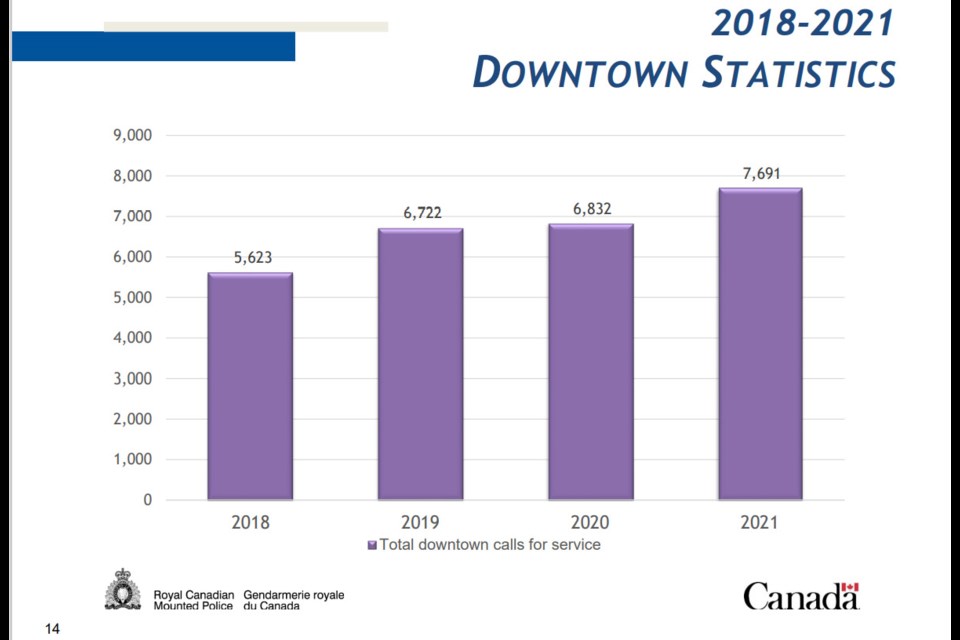Prince George had nearly double the crime rate and Prince George RCMP officers are handling roughly 50 per cent heavier caseloads than police officers in similar-sized B.C. communities, according to a report to city council Monday.
Prince George RCMP generated 50,182 case files in 2021, up 6.93 per cent from 2020. Prince George RCMP Supt. Shaun Wright presented city council with his 2021 year-end report on Monday. In addition to providing local statistics, he provided a comparison between Prince George and three similar-sized B.C. communities: Kelowna, Kamloops and Nanaimo.
“(This) gives you an idea of what we’re dealing with here. Prince George has the lowest population… and is the highest in Criminal Code offences,” Wright said. “You can see by our case load per member, we’re really stretched…”
Drawing on 2020 crime data reported in September 2021 by the B.C. Ministry of Public Safety and Solicitor General, Prince George’s crime rate was 209.1 Criminal Code of Canada offences per 1,000 population – compared with 111 in Nanaimo, 114 in Kelowna and 116 per 1,000 people in Kamloops. The provincial average crime rate is 76 offences per 1,000 population.
Police officers in Nanaimo, Kelowna and Kamloops carried an average caseload of 76 to 82 cases, compared to 121 in Prince George. On average across both municipal police forces and RCMP forces in the province, the average caseload per officer in the province is 53, Wright wrote in his report.
The Crime Severity Index, a weighted crime rate developed by Statistics Canada, for Prince George in 2020 was 223, compared to 130 in Kelowna, 123 in Kamloops and 112 in Nanaimo.
Statistics Canada has a complex formula for calculating the index, so that it “gives a better idea of what is happening on the ground,” Wright said. A shoplifting and a homicide are both a single Criminal Code of Canada offence, but they are not equal in seriousness or in the amount of police resources used to investigate them.
“We’re about 80 per cent higher than our comparator communities,” he said.
The number of case files in the city has been trending upward over the past four years – 44,118 in 2018, 48,022 in 2019, 46,927 in 2020 and 50,182 in 2021, according to the report.
Calls for service have been increasing steadily in the downtown area, Wright added. In 2018, the RCMP received 5,623 calls for service downtown. By 2021, that had increased to 7,691.
“Encampment was a big issue this year. It occupied a significant amount of our downtown resources,” Wright said.
Most of the crime downtown is minor, he said - mischief, causing a disturbance, suspicious people and being intoxicated in a public place were the most common.
In addition, RCMP did 668 wellness checks and dealt with 289 mental health episodes downtown in 2021, Wright said. The RCMP treated 52 overdoses with Naloxone kits last year – up from only 12 in 2018 – of which, roughly 60 per cent were downtown.
The RCMP is increasingly being asked to take on jobs outside of their core policing responsibility, Wright said, something he and his leadership team are looking to address this year.
“We don’t need to be doing the job of other agencies. We become the default social service after 4 p.m., and after Friday until Monday,” he said. “Over the years, because were the 24-hour service, we’ve acquiesced and taken these things on. We don’t have time to be doing other people’s work, we barely have time to do our own.”
‘I’M REALLY SICK OF THESE LOSERS’
Coun. Cori Ramsay brought forward a motion, calling for an independent review of the city’s policing needs. The cost of the report is expected to be under $50,000 and come out of the city’s current budget.
Even if the report says the city needs dozens of extra police officers, that is important information for city council to know, she said.
Ramsay said she was shocked to see how much higher Prince George’s crime rate is, compared to similar-size B.C. municipalities, and asked Wright if he had any insight into the root cause.
“Do (people) actively come to Prince George to commit crime?” Ramsay asked. “It’s impacting people at such a high rate, compared to our peer municipalities. At what point is it going to get to where people don’t want to live in Prince George anymore? That’s what I worry about.”
Blue collar communities tend to be “a little rough around the edges,” Wright said, but the root causes of crime are highly complex and would be better answered by a study conducted by qualified researchers. Wright said he was look into what would be involved to conduct such a study, and would bring back information to council later.
Coun. Murry Krause said a study addressing the root causes of the city’s high rate would provide council with a useful tool to make change.
“There is nobody in this room that can say what the root cause of the problem is,” Krause said. “I look forward to a proposal to have a good study done. I want something that is really specific to Prince George.”
Coun. Terri McConnachie said city council only has two tools to address crime in the city: the RCMP and the city’s bylaws and bylaw enforcement.
“Thank you for your report. It’s sobering, it’s enlightening and frankly, It’s frightening,” she said. “(But) we’re still going to have crime and we’re still going to have encampments as soon as the weather gets good.”
Coun. Kyle Sampson said it’s a shame the city had to increase its policing budget this year to cover costs associated with the contract negotiated between the federal government and RCMP union, instead of being able to invest in additional police resources.
“I think we need more boots on the ground,” Sampson said. “We’re seeing a huge increase in property vandalism in the downtown, fires in the downtown. I’m really sick of these losers committing a bunch of crime in our community.”



